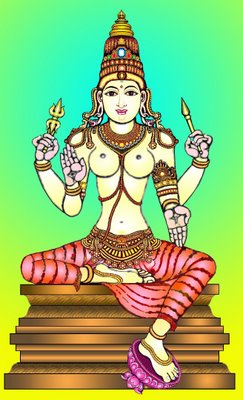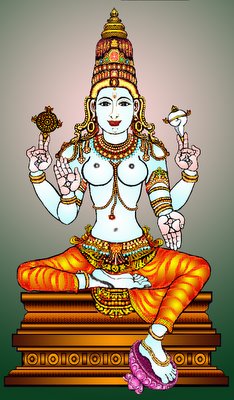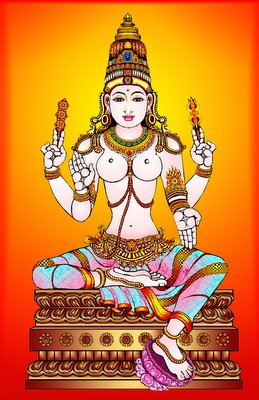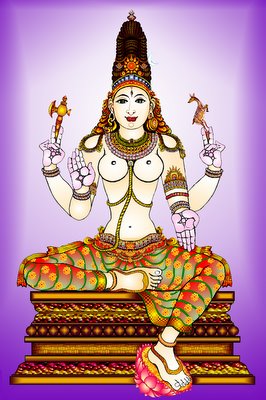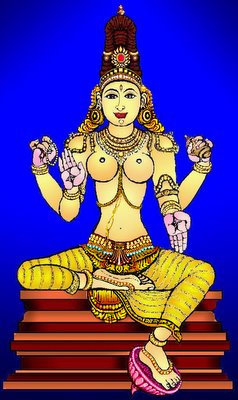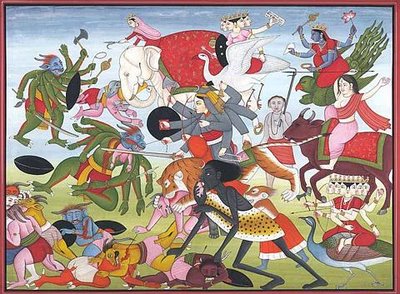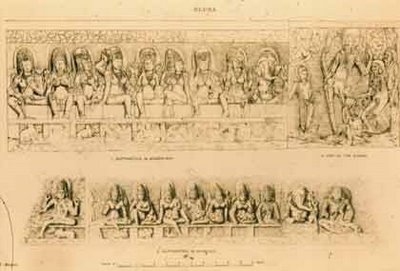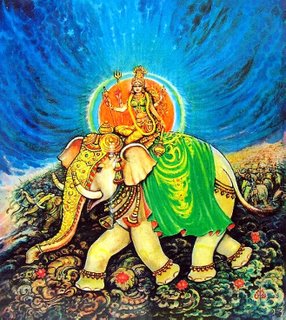Sapta-Matrukas in Puranic Lore

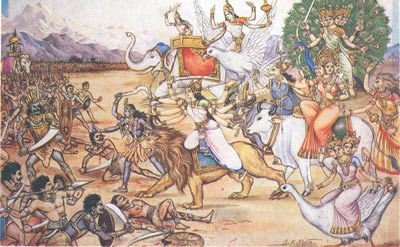
The Seven Divine Mothers are indeed an interesting group of goddess, and in the hindus perception of divine feminine, they occupy an important place. Nevertheless the myth about the Matrukas does not only confine in vast Hindu pantheon, but also in the other cultures. There are many different myths about the origins of the Saptha-Matrukas. They are being mentioned several times in several text namely the Mahabaratha, Devi Mahatmya, Linga-purana, Matsya-purana, Bhagavata-purana and Vishnu-dharmottara-purana. They have a common attribute namely the auspicious and the inauspicious form. More often they are being known for their inauspicious form. By and large they always function as a group and share common attributes. Many times they are unspecified in numbers. In their “Auspicious form” they function as a supportive role in maintaining Dharmic cosmic order as :
1) Warrior Goddesses :-
(a) In Devi-Mahatmya : As Seven Mothers, they battle together with Durga, Sivaduti and Chamunda against Subha and Nisumbha. (b) In Varaha & Matsya-purana they assist Siva in combating against Andhaka. In association with Karthikeya, they fought with him against demons. In relation to the battle they fought together with Karttikeya, some of these Matrkas are described as having lovely form, cheerful, fair skin and youthful. Others are often depicted as having long nails, large teeth and protruding lips. They inspire their foes with terror, and they are like Indra in battle. They live in trees, at crossroads, on mountains, at spring, in burning grounds, and they speak a variety of languages. More often they are dark skinned.
2) As Mothers, there are several myths about the role the Matrkas played especially with Hanuman & Karthikeya :- (a) It is said Karthikeya was born from the spark of Shiva’s third eye into six babies. He was looked after by six Mothers [ possibly gauris ] till he is a young boy. Parvathi then came, and merge all these six babies into “One” as Shanmugha. These six mothers then became stars – Constellation of Karthika. And it is said that during Karthekai night, these six stars are visible in the night sky. (b) A myth tells a story of two sisters give birth to half a child, they abandoned the deformed creatures at cross roads. Jara, a demon goddess { she feeds on flesh and blood } take the child away, combined the two infants into a whole being and she gives the whole child to the king. In gratitude the king orders that she be worshipped throughout the region at a great festival in her honour. In their inauspicious forms, of which they are commonly referred to, they are often depicted as ferocious , terrible, dangerous to children and pregnant woman. There are several myths to this association with children, more often with Karthikeya. The Matrkas are being sent by Indra to kill the youth Karthikeya shortly after his birth. When they approached the child, however their breast ooze milk and they asked him to adopt them as his mothers. Two of these goddess are described as a) born of anger and to carry a spike on her head b) bad tempered of red complexion, a daughter of the sea and live on blood. Another myth in association with Karthikeya mention about a host of ferocious and terrifying ones, born from the child when Indra strikes him with his thunderbolt. These goddess are as follows : Kaki, Halima, Malini, Brhali, Aryu, Palala, and Vaimitra. Karthikeya eventually adopt them as his mothers. With regards to the Six mothers who take care of baby Karthikeya, there is another myth to the story. It is said that the six mothers who take care of Karthikeya are the wives of Six sages. They have been wrongly accused for being Karthikeya’s real mothers. They are then divorced by their husbands and so come to Karthikeya and appeal to him to adopt them as his mother. As a group they are then being called the Maha-Matrkas [ The great mother ]. He agrees to become their adopted son and asked them if they have any wishes . They made two wishes namely to be recognized and worshipped as “The Great Goddesses” and to live off the children of men because they themselves have been divorced and cheated of having a children of their own. Karthikeya however refused to grant them the second wish, but instead told them that they can play a "protective" role as mothers to these children. Karthikeya later told them that they can torment children until they reach 16 years of age. Just as Mariamman is associated with diseases, the Matrukas are seen as being behind the illness and death of children. Since Devi is all, it is inevitable that some of Her forms will represent the most fearful elements of Nature. In short, the Seven Mothers are the handmaidens of Chandi [ Durga or Parvati ], who declared her Seven handmaidens to be worshipped as virgin mothers. This cult of the Seven Mothers is found all over India. Pregnant women and nursing mothers worship them. When these goddesses are angry, they make women barren and strike newborns with fatal fevers. When they are appeased, they ensure the health and happiness of children. The behaviors of the Matrukas are no different than what is portrayed of Maha-Kali. The Matrukas are too part of the Mother. In Devi-Purana they are said to be the multiform of the Mahavidyas. Now to say that the Matrukas are totally out of control is not true because they too have their limitations. Its when they go beyond the limits that they become Demons and Asuras, thereafter need to be punished. The following instances explain as to why I say the Matrukas is not totally uncontrollable :-
1) After the battle the Matrukas announce they will now proceed to devour all the gods, demons and people around the world. Shiva commands them not to do this, but they ignore him and begin a rampage of destruction. Shiva summon Narasimha, Vishnu's man-lion form who creates a host of benign goddesses and they in turn calm down the terrible Matrukas and stop their destruction, of which they did.
2) The demon Sumbha has accused Devi of false pride an haughtiness, for in the foregoing encounters she has relied not on her own strength but on that of others. At this point, Devi proclaims her relation to the apparently heterogeneous forms of the Goddess : “I alone exist here in the world, what second, other than I, is there ? O wicked one, behold these are my hierophanies ( or extraordinary powers ) entering back into me”…. Thereupon, all the goddesses, led by Brahmani, went to their resting place in the body of Devi, then there was just Devi alone. Subsequently, Devi throws own the gauntlet for the final combat:"when I was established here in many forms, it was by means of my extraordinary power. That is now been withdrawn by me. I stand utterly alone. May you be resolute in combat"

